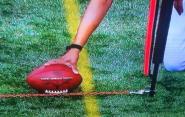Thanks To Yale Engineering Alum, We Always Know Where 1st Down Is

Years ago, in a much more primitive era of watching football on TV, the question of whether a team had made first down required a lot of guesswork and huddling closely to the television screen.

But these days, the first down question is one answered readily with the help of a yellow line that appears only to TV viewers. For that, we have Yale Engineering alum Stan Honey '78 to thank. His company, Sportvision, developed the technology – known as the Virtual Yellow 1st & Ten line system - which debuted in a 1998 game between the Bengals and Ravens. Honey developed the idea as part of long-term collaboration he had with David Hill, then the producer of Fox Sports.
Today, a generation of football fans has grown up with the virtual line. It's something that's so integral to the football-watching experience that it's easy to take for granted. But on the first broadcast, TV viewers were astonished by the technology. Honey said phones were ringing at the station nonstop from people wanting to know whether the line was real or not. "There was a flurry of conversation about what it was, and how it was made," he said.

It's at once vibrant and easy to see, without seeming unnatural to the action at hand. Although it's computer-generated, the line looks as if it's painted right on the field – when players step where the virtual line is, the line looks to be beneath their feet. To the casual viewer, all this might seem a very clever, but not overly complicated thing to achieve. But it is indeed complicated. A 3D model of the field, lots of computer power, and specially designed video cameras are just a few of the things needed to pull this off.
"At first, it was a lot more difficult than it is now - it was barely possible to do at the time with the computers we had," Honey said. Initially, the system needed a 50-foot truck to house all the computers that were needed, he said. Now, everything fits into a box as big as a medium-sized refrigerator.
Almost as remarkable as the technology was the near-immediate acceptance. Traditions hold fast in sports, and fans don't often take to change easily (Remember when Oakland A's owner Charles O. Finley tried out orange baseballs? That didn't go so well). But a survey taken shortly after the technology debuted found that more than 90 percent of viewers wanted the virtual line to continue.
An early version of Sportvision's technology first appeared in hockey, in the 1996 NHL All-Star Game. Known as FoxTrax, the technology used different colors to illustrate the path and speed of the puck. Other versions of the company's technology have been used to create the virtual advertisements on sports fields.
Honey sailed competitively while he was a student at Yale in 1978 before graduating with a bachelor's of science in engineering and applied science. He has since left Sportvision to devote himself to the world of yachting, where he's been remarkably successful. He was named the Rolex Yachtsman of the Year in 2010, and combining his sailing interest with engineering know-how, has served as the technical director of America's Cup.
(photo of virtual line: Intel Free Press)

